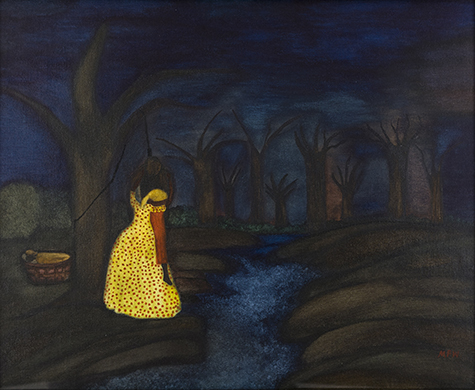 "Sari-Mae's Sorrow," 1996, watercolor on canvas board, 16 x 20 inches. Private collection.A series of exhibitions and programs by artist Mary Frances Whitfield will be presented in part by the University of Alabama at Birmingham in collaboration with campus and community partners.
"Sari-Mae's Sorrow," 1996, watercolor on canvas board, 16 x 20 inches. Private collection.A series of exhibitions and programs by artist Mary Frances Whitfield will be presented in part by the University of Alabama at Birmingham in collaboration with campus and community partners.
UAB’s Abroms-Engel Institute for the Visual Arts will present “Mary Frances Whitfield: Why?” from May 31-Nov. 23, with an opening reception at 6 p.m. Friday, May 31. A panel discussion on the legacy of lynching and racial terror in the deep South and the role of art as a conduit for reconciliation and healing is scheduled before the reception for 5 p.m. in the AEIVA, with moderator DeReef Jamison, Ph.D., associate professor of African American Studies in the College of Arts and Sciences at UAB. Panelists will include Paulette Dilworth, Ph.D., vice president of Diversity, Equity and Inclusion at UAB; AEIVA Curator John Fields; Darrell Forte, president of the African American Studies Association at UAB; Abigail Schneider, project director, Jefferson County Memorial Project; and Charles Woods, education programs manager, Birmingham Civil Rights Institute.
The events are free and open to the public. The exhibition is a collaborative program between AEIVA, the Office of the Vice President for Diversity, Equity and Inclusion at UAB, and the Birmingham Civil Rights Institute in conjunction with the Jefferson County Memorial Project.
One of the most significant of Alabama’s “outsider artists,” Whitfield uses painting to create intimate windows into her cultural past. Inspired by the rich and illuminative ancestral history offered in the stories told by her grandmother, Whitfield’s paintings present an affecting portrayal of daily existence for African-Americans living in the southern United States during the 18th and 19th centuries.
Following her first visit to the Birmingham Civil Rights Institute, Whitfield was inspired to explore a much darker segment of her family history than she had previously done. “Mary Frances Whitfield: Why?” presents a series of paintings that graphically depict horrific racial terror lynchings perpetrated against African-Americans. This marks the first time these particular works have been exhibited in Whitfield’s hometown of Birmingham, Alabama. This exhibition also represents the artist’s first solo museum exhibition in Birmingham. A portion of this exhibition will also be on display at the Birmingham Civil Rights Institute. The works featured in "Mary Frances Whitfield: Why?" will be on loan from local and regional art collectors, and from Phyllis Stigliano Projects in New York City.One of Alabama’s most important contributions to the visual arts is that the state has produced an impressive number of important outsider artists like Thornton Dial and Lonnie Holley, says AEIVA Curator John Fields.
“I think the high concentration of these artists in the Birmingham area has overshadowed Mary’s work to some degree,” Fields said. “Mary was born here, she was inspired to create these works as a direct result of Birmingham’s history, and I don’t think these paintings have ever been exhibited here. I believe Mary’s paintings deserve a closer look as significant works of art.”
This exhibition was developed in conjunction with the Jefferson County Memorial Project, a grassroots coalition of community leaders working with the Equal Justice Initiative to retrieve Jefferson County’s monument from the National Memorial for Peace and Justice in Montgomery, Alabama. The coalition hopes the opportunity to retrieve the monument will be a step toward reconciliation, and make a statement that Alabamians are leading the charge in confronting our past and advocating for a better future.
| This exhibition was developed in conjunction with the Jefferson County Memorial Project, a grassroots coalition of community leaders working with the Equal Justice Initiative to retrieve Jefferson County’s monument from the National Memorial for Peace and Justice in Montgomery, Alabama. |
“We believe this exhibit, and art more generally, is an important way for people to process this traumatic history,” said Abigail Schneider, JCMP project manager. “It is a necessary complement to the other public education events we’ll be hosting throughout the summer. Additionally, JCMP tries to emphasize that this is not a history of victimhood. Black activists in Jefferson County protested these acts of racial terror and protected black lives from white mobs. Mary Whitfield is another such example. She used her art to draw attention to atrocities that parts of the community would have preferred to keep hidden.”
“Mary Frances Whitfield: Why?” is co-curated by AEIVA Curator John Fields and Brandon Wolfe, Ph.D., assistant vice president of Campus and Community Engagement.
“While this particular exhibition may be hard to digest for some participants, the history of lynching remains a part of our nation’s fabric,” Wolfe said. “It is my desire that the Whitfield exhibition will serve as a focal point for thoughtful and engaging dialogues as well as historical reconciliation.”
AEIVA is open to the public 10 a.m.-6 p.m. Monday-Friday and 12-6 p.m. Saturday. It is closed Sundays and holidays.
